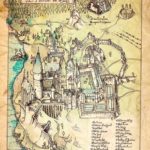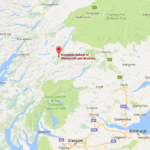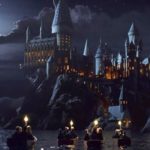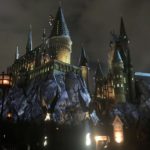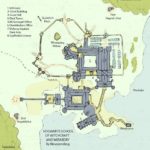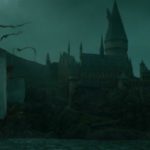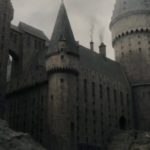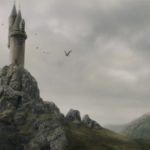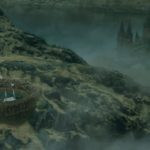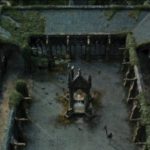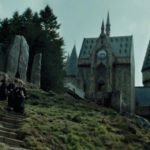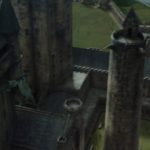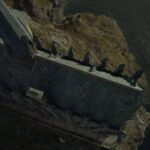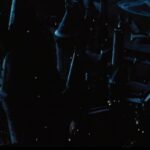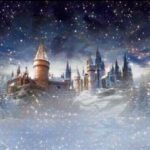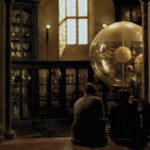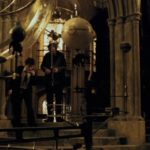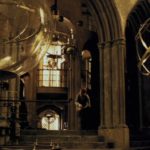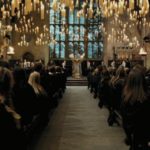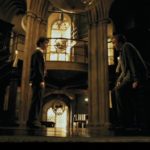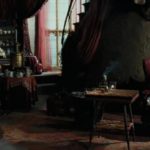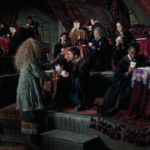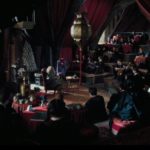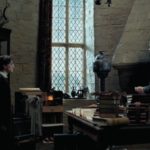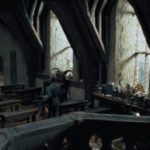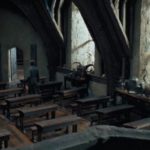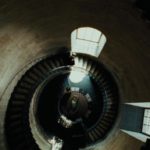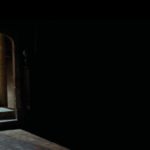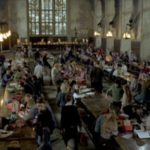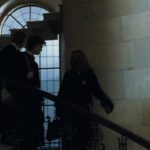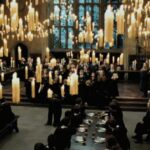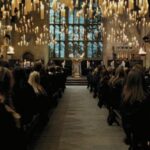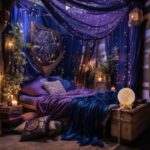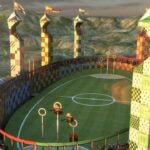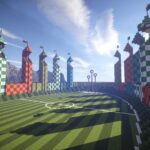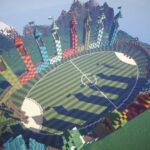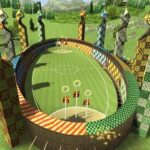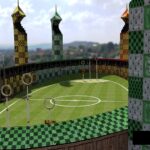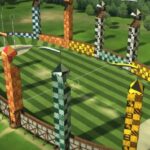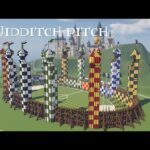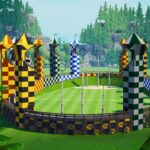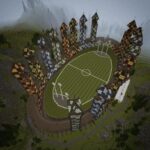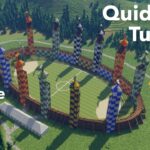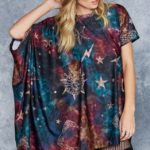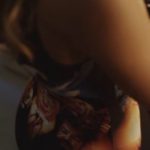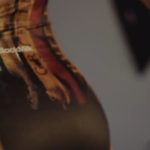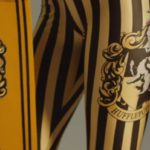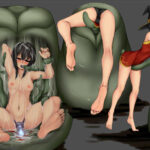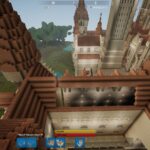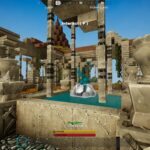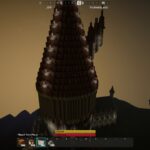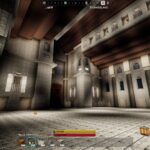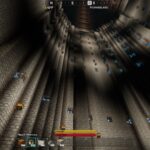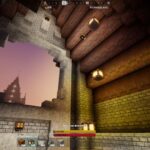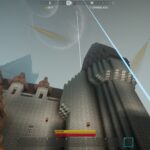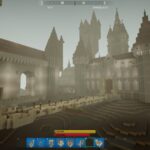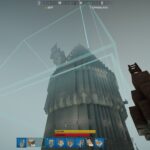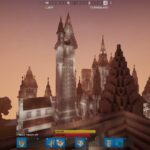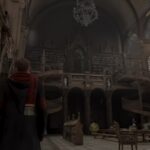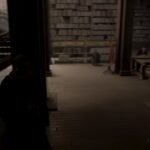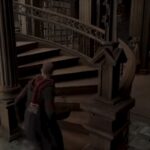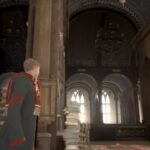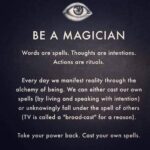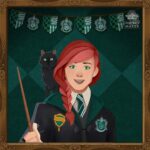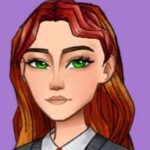This is our architectural copy of the computer-animated one featured in the movies (which was inspired by Alnwick Castle in Northumberland, England). Yes, just as in the films, some people live and work here, and plenty study, learn, and practice various forms of magic in its halls and out across the grounds. Broomstick Quidditch is also played at and above its stadium.
–
Table of Contents:
- Preface/Vocabulary
- Dimensions & Layout
- Students
- Uniform
- Homework
- For Reference: Magic Types from the Books
- Additional Notes
- 2020 Update: Name Change
- 2022 Update: Capacity, and Population Over Time
- Overall (Images Begin)
- Exterior
- Interior
- Quidditch Pitch
- School Uniforms
- 2023 Update: Hogwarts Full-size Model in Creativerse
- 2023 Update: Views from Hogwarts Legacy (Video Game)
- Concepts/Memes
–
Preface/Vocabulary:
Adding the “k” to “magic” is not merely an affectation. Rather, it is a way to discriminate between the entertainment known for pulling rabbits out of hats (magic) and techniques for harnessing internal and external energies which will help us change ourselves and our environment (magick).
–
Dimensions & Layout:
Based on the maps, footage, and the blueprint/s the movies/studio used (available in one of the books now), this campus spans ~1,500′ x 1,500′; 2,250,000 square feet (>51.6 acres). Our copy of it here in Inisfree matches the arrangement of buildings featured in the film/s. The only major difference is the classrooms; the rooms are the same, as are the hallways and turret stairwells (spiral staircases) connecting them, but we teach different classes/material in those rooms.
–
Students:
You’ll find the three blonde sorceresses (featured in some of the films) here, along with their long-time friend and fellow sorceress, Cho Chang. Some of the many others of the magical arts who help teach and train here include:
- Ambrosia LeMorte: ancient vampire, practitioner of Temporis and other sciences, and Inisfree’s High Queen
- Ariel: a gift from the High Queen
- (the blonde(s) in H.P.): a sorceress and model from Scotland
- Cho Chang: a sorceress and model from China
- Clarissa Adele Fairchild: “Clary Fray”, a hunter of misbehaving supernatural beings
- [Dragon Lady]: an ancient dragon which shape-shifts into the form of a beautiful elf-like blonde
- Freyja: ancient goddess, one of the race called Vanir, exceptional at a wide variety of magical arts
- Illyana Rasputina: descendant of the legendary Russian healer chosen by the royal family, she has become entrusted with one of the Infinity Gems, and can regularly access Purgatory and other dimensions, even teleporting other people with her
- Jaina Proudmoore: ancient arch-mage from a time when dinosaurs still roamed the Earth, and the elf-castles were still fairly new, none yet in ruins
- Lilly Evans: mother of the famous Harry Potter
- Maria Orsic: famous woman from Europe who worked with secret societies during and before WWII, utilizing Vril and Seidr, making telepathic contact with people (such as some Pleiadians) from other worlds, providing the first conceptual sketches and notes on how to create Repulsines, and who later migrated to another planet and civilization (in Aldebaran)
- Teagan Strange: daughter of Dr. Stephen Vincent Strange, the Sorcerer Supreme
- Wanda Maximoff: ‘the Scarlet Witch’
- Xull’rae Zauviir: dark-priestess and princess from the Underdark of Earth; the cave network realms where the Drow (Dark Elves) live
Those who prove themselves at this war-free magic-haven inspired by its namesake… are sometimes invited up to the Governor’s Mansion, through which they may eventually earn the chance to join the best practitioners of the magical arts down in its lowest basement; the facility called ‘The Magics Chambers’.
–
Uniform:
School uniforms worn by all students attending this castle are shown in a photo album below. They are the sexiest imaginable versions of what was seen in the films, as well as a variety of inspired articles by Black Milk. Because of that latter custom clothing producer’s compatible garments, they have the option of producing everything for our students here (though we can always 3D-print our own).
–
Homework:
As our version of Hogwarts is based on love/compatibility, not conflict, we teach a slightly different curriculum (or array of curricula, rather). It starts with basic magics, such as learning how to focus one’s energy/intent through a wand or other object/channel. This then progresses into the named disciplines of advanced science, which humans sometimes think of as ‘magic’:
- change-based / transmutation / alchemy; converting something into something apparently unrelated (or difficult to convert to)
- chaos-based / results/success-based; achieving things in spite of the current flow/trend/theme of the era/Age one is in, as well as actual-chaos magic/spells (such as creating ‘variables’; unexpected or difficult-to-predict elements in situations)
- concealment/camouflage-based; just what it sounds like, including making invisibility-cloaks, hidden magical-effect fields, etc.
- creation-based; making objects seemingly out of thin air
- enchanting; adding effects/abilities/powers to objects, such as a necklace or pendant that grants the wearer (or only a particular/approved/chosen wearer/possessor) immunity to/from sunlight/radiation
- health/healing-based / faith-based healing/medicine; the only true form of medicine and healthcare (as all else is assumption-based and an over-complication/corruption of this ancient science developed in the distant time when the first disease became possible), and it even includes (at one of the later stages of advancement through the grades here) necromancy (how to communicate with and raise/resurrect the dead/fallen/departed)
- locating-based; finding/sensing things even when they are well hidden
- nature-based / plant-magic; how to heal plants, restore or re-balance ecosystems, re-green areas, grow plants more quickly than they grow around humans (only because humans were brainwashed not to love plants or will them to grow at their normal/original rate), etc.
- protection-based; charms, seals, wards, etc.
- sex-based / sex-magic / tantric (sex); how to activate one’s entire body/being, as well as the entire body/being of as many sexual partners as are present (or, at least, telepathically connected to/with), in order to enable/unlock better (and eventually the best/potential/maximum) mental and physical abilities (though Inisfreeans know mental ones are part of physical ones), etc.
More magical subjects TBA…
–
For Reference: Magic Types from the Books
Magics of the Harry Potter series ranked by apparent power:
- Dark Magic: In many ways, this is not truly a separate branch of magic– it is the use of any of the other branches of magic for dark purposes. This form of magic takes those spells that can be useful and turns them into tools to hurt, or even to kill others. – Poisons, curses, hexes, and jinxes are classified as Dark Magic, although these can range from the kind of hexes that schoolkids use as pranks (like the Bat-Bogey Hex) to the illegal Unforgivable Curses that torture, control, and kill. – Dark Magic is, unsurprisingly, one of the most powerful forms of magic there is– this is in part due to the power of the spells themselves, and in part due to the witch or wizard who uses truly Dark Magic does not care about the limitations of magic for the safety of others, only for their own gain.
- Time Travel (Time Turners): Obviously, the ability to alter time itself is one of the most powerful forms of magic that there is– so much so, in fact, that Time Turners are heavily regulated by the Ministry of Magic. – While there are those people who will carefully alter only the smallest details in order to do something productive (like Hermione and her use of a Time Turner to study more subjects than would otherwise be possible), the temptations to change major events would simply be too much for the vast majority of witches and wizards (as we saw in Harry Potter And The Cursed Child). – The older Time Turners are also dangerous to the witch or wizard themselves, as staying in the past for more than a few hours can have devastating effects.
- Wandless Magic: The vast majority of magic in the wizarding world of Harry Potter requires the use of a wand, and much of it also requires the use of other tools, items, or spoken words. – However, some wizards are able to perform specific magic without the use of these things– from non-verbal spells (which are relatively common) to wandless magic, which is extremely rare. – If a wizard has the skill to do magic without a wand, however, it makes them extremely powerful– there is no fear that they will be helpless if their wand is lost, or broken, and they can use spells at the speed of thought, without needing to make any kind of wand movement at all. – This also means that in duels or battles, it is impossible for an adversary to know what they are planning to do, making this a rare but extremely powerful form of magic.
- Legilimency/Occlumency: These arts are two sides of the same, telepathic coin. Legilimency is the magical ability to read minds (in essence), to dig into the mind of another human in order to discover their true intentions or to uncover memories. – Occlumency is the art of closing off the mind in order to stand up to a Legilimens. There are a few ways that both of these can be accomplished, and some can probe the minds of others with great delicacy, leaving their target almost unaware that it has happened. – Others need to barge into a mind, something that can be painful– which some Legilimens don’t mind, of course. Both of these arts can be extremely useful, and take quite a bit of skill, but reading minds isn’t the same as changing them, making it less powerful than many other arts.
- Alchemy: Alchemy isn’t a subject taught to everyone at Hogwarts school of witchcraft and wizardry, although it can be an option for higher-level students if there is demand. – Linked closely to potions and transfiguration, Alchemy is the study of the basic elements and the transmutation of matter – complex, very scientific (as far as magic is concerned), and difficult to master. – However, there is great power in Alchemy, because a true master of this branch of magic is also a master of death, thanks to the Philosopher’s Stone. An alchemical legend, the stone allows the user to brew the Elixar of Life, as well as to turn any metal into pure gold– making the wizard who accomplishes its creation rich and functionally immortal. – While it’s not useful in a battle, it’s incredibly powerful in a different sense.
- Arithmancy: Many casual fans of the Harry Potter series don’t have a good idea of what, exactly, arithmancy is– other than knowing that it was one of the many subjects Hermione took and has something to do with numbers. – For many, it’s seen as a sort of magical calculus… which isn’t too far off. Arithmancy is a form of magical numerology and divination, often used to predict the future. – However, the real power of Arithmancy lies in its connections to the creations of new spells. Spellcrafting is a complicated subject that isn’t dealt with in great detail in the Harry Potter series, but Arithmancy is a big part of it, meaning that someone truly gifted in this branch of magic will have a stronger ability to create entirely new magic– and that is real power.
- Charms: One of the best known and most commonly used branches of magic, charms are the spells that change the properties of an object or creature– allowing it to fly, to change mood, to be protected, etc. – Charms can be seen as a softer option, and can be very minor spells– like Molly Weasley’s self-washing dishes. However, Charms should not be underestimated. Some of the most powerful spells in existence are charms, like the Fidelus Charm or Memory Charms. – The sheer range and usefulness of most charms is also huge, with this branch encompassing the vast majority of day to day (and even battle-worthy) magic, making this area of magic as a whole vastly powerful… although obviously, not every charm carried great power individually.
- Transfiguration: Transfiguration is an exacting, complex discipline of magic, and one that focuses not just on changing what an object or creatures does (like charms), but what it essentially is. – On a more basic level, transfiguration can be something as simple as turning a mouse into a teacup (although even this is not easy magic), but at the most complicated levels, Transfiguration can alter almost anything– with the only limitations being the skill of the witch or wizard, and an inability to restore life after death. – Transfiguration also encompasses the creation of an Animagus– a witch or wizard who can transform themselves into an animal at will, but retain their human mind. This is extremely difficult and carefully regulated by the Ministry of Magic, which should say something about how powerful high level transfiguration can be.
- Potions: Potions, or potion-making, is a wide-ranging art, with potions being used for all kinds of applications in the magical world. Medical magic makes use of potions, and potions can even be used in lieu of other magical forms (such a poly-juice potion, which is used as a way of transfiguring a witch or wizard without needing to use transfiguration magic per se). – One of the most useful things about potions is that once brewed, they allow any witch or wizard (no matter their skill level) to utilize that magic; therefore, potions make higher forms of magic accessible even to those who are not particularly talented themselves. – There are also extraordinarily powerful potions, including love potions and poisons, that are carefully regulated– although the majority of potions don’t fall into this category.
- Medical Magic: The practice of medical magic can include various other forms of magical work (such as potions), as long as they are in the pursuit of improving the physical condition. – Medical magic gives the wizarding community the ability to deal with almost all muggle health complaints easily (like a broken bone or common cold), although it’s not always so effective with healing the after-effects of magical injuries (like a memory charm gone wrong, or a magical illness). – This is a very useful branch of magic, and one that is certainly a good one to know when running from and fighting Death Eaters… but it’s not one of the most powerful. – The ability to deal with a ruptured appendix without surgery is huge, but there seem to be as many magical ailments as there are muggle ones, so this is not necessarily more powerful than muggle medicine.
- Herbology: The study of magical plants is comparable to Muggle botany, and isn’t a particularly powerful branch of magic, although it is a useful one. Herbologists focus on the care of plants as well as their uses, and the most common practical use of herbology is to cultivate and gather plant ingredients for potions and other branches of magic. – While a few plants do have their own inherent magical properties, these are not always the core focus of the discipline. Like the study of Magical Creatures, this branch of magic is largely about understanding and caring for other living things, and finding ways to use their magic in the works of other witches and wizards. – There’s no doubt many powerful potions wouldn’t exist without herbology, but it’s not too powerful on its own.
- Divination: Even in the wizarding world, the ability to see the future isn’t something that can simply be learned by dedicated study. Clairvoyance is one of the few gifts in this world (like Parseltongue, for example), that some witches and wizards simply have naturally. – However, various forms of divination can still be studied and honed, and talents can be wasted or used carefully. That said, even the most powerful clairvoyants are only able to see the future in extremely vague terms. – Prophecies can be misunderstood, misheard, and difficult to interpret (as the Harry Potter/Neville Longbottom possibilities show so well). Many witches and wizards (like Hermione, who makes no secret of hating it) find it too wishy-washy to be really useful, although it is definitely interesting.
- Underage/Accidental Magic: While adult wizards are careful to manage their magic and direct it only where they want it to go, children don’t have anywhere near that kind of control. – Underage wizards, and especially witches and wizards under the age of eleven, often find that their magic comes out in unexpected ways… like the time that Harry accidentally freed a snake at the zoo, or– more disturbingly– when Tom Riddle used his magic to frighten or hurt other children. – In some ways, this kind of uncontrolled magic can be very dangerous, as powerful children can cause real damage when they are afraid or angry. However, compared to any kind of skilled, directed magic, underage/accidental magic just doesn’t stack up in terms of power.
- Wandlore: Wandlore is certainly one of the least flashy or exciting branches of magic, although it is vital to the practice of the magical arts. Without wandlore, though, the vast majority of witches and wizards would be incapable of most of the magic they do– as only a few in the magical community have the ability to do wandless magic. – Wandlore deals with the magical properties of the woods and cores that are used to create wands, and the properties of the wands themselves. – Those who study wandlore can create tools of great power, although those wands then choose the witch or wizard to work with (in their own way), so even a great wandmaker may not be capable of building themselves a wand that gains them more power overall.
- Broomology: This little-mentioned branch of magic is hardly glamorous, but it’s a very necessary one. Broomology is the study and design of magical broomsticks– and covers everything from the principles that govern flying broomsticks, to broomstick building and repair. – In many ways, this is one of the most mechanical aspects of magic, although it involves a little more than muggle car repair might. Although broomology is useful for everything from transportation to the noble game of Quidditch, it’s one of the least powerful branches of magic. – Given that there are other magical modes of transportation (and that many witches and wizards prefer the faster options like the Floo Network and simple Apparition), it could be argued that this is only truly “powerful” to Quidditch players and fans.
Details about the magic mentioned in the Harry Potter series can be found here.
–
Additional Notes:
As powerful as some of those magics are, most masters and professors still have not figured out that they are more based on intent/willpower/belief than anything else; this is to say that the ways in which they are practiced/brewed… are more ritual (and a means to over-complicate, thus control/restrict their use) than anything else. In other words, you can do anything you really set your mind to, including using all those magics, and producing all their effects, without any wands or recipes/ingredients at all. Teaching the magically-inclined that they needed all those other things was really just a way to slow and regulate them over the years and eons, reducing the conflict/destruction of the previous Ages.
Female students (yes, of all ages) invite High King Auz to their dorms to help with their homework-sex, as he is the sex prophet of this final era/Age, and as Inisfree is to teach the worthy how to finally have sex appropriately, thus he is the head of its faculty, and the top T.A., and their favored tutor. Those who do well and best at his dorm tutoring sessions? He tells them they will soon be able to help use the sex-magic they mastered… in the Magics Chambers, meaning they with him will get to unlock the rest of the secrets of Vril/Chi and the Universe. Such is the Inisfreean Way. Amen.
–
2020 Update: Name Change
As of November this year, this location/structure in Inisfree will no longer be called or listed as “Hogwarts”, as that is a gross combination of words, and no gross spells/utterances are allowed/wise in the Inisfreean realm. Instead, this castle and its learning program are here-to-forth known only as “Inisfree’s School of Witchcraft and Wizardry”. S.W.W., for short.
It is called our school of witchcraft and wizardry (as opposed to just one or the other) because we wisely keep the two sexes distinct; some magic is best only for males, and other magic for females.
–
2022 Update: Capacity, and Population Over Time
Hogwarts Castle (just the frequented floorspace/classrooms/levels in its main cluster of buildings) spans ~414,000 sq.ft. (9.5 acres); it would be ~643’x 643′ if even on all sides of its property or footprint (~2 football fields x ~2 football fields).
In the series of novels about this school, there were ~1,000 students spread across its 7 grade-levels (for ages 11 through 17; grades 6 (start of middle-school) through 12 (high-school senior)); ~143 students per, thus ~414 sq.ft. (20’x 20′) per student at ground-level.
It has seven floors, 142 staircases, numerous turrets and towers, greenhouses, and a sports stadium; it is much taller and more spacious than a normal high school or university with a similar student body/population.
By comparison,
- Dartmouth has a student population of 6,350 on a 11,717,640 sq.ft. (269 acre) campus (~3,423’x 3,423′ if sides were even).
- Harvard has 22,947 students on a 25,000,000/+ sq.ft. (574 acre) campus (~5,000’x 5,000′ if sides were even).
- Texas A&M has 72,982 students on a 226,510,000 sq.ft. (5,200 acre) campus (~15,050’x 15,050′ if sides were even; ~2.8 x 2.8 miles).
- Berry College has students on a 1,176,120,000 sq.ft. (27,000 acres) campus (~34,294’x 34,294′ if sides were even; ~6.5 x 6.5 miles).
- Most colleges/universities have 5,000 to 15,000 students; Hogwarts School of Witchcraft and Wizardry is a considerably small/exclusive, not just private, school.
Old Calculations:
Inisfree had a guest (non-ICV) population of ~1,000,000 in 2015, and ~5,000,000 by 2100; it saw a fairly steady increase in guests and residents, ~47,058 more/new individuals during each of those 85 years.
In 2022, that population reached ~1,329,411, many of them only there for a few weeks at a time (per year).
Extrapolating from the percentage of characters/individuals on our Character Groups Directory who know some form of ‘magic’ (advanced science), ~9% of our non-ICV population probably knows some ‘magic’, with a portion of them choosing to practice and/or learn more about ‘magic’ at this school.
Estimating ~5% of Inisfree’s annual guests choose to take at least one class at this school, in 2022 that would be ~66,470 students (comparable to Texas A&M or to the University of Central Florida).
(It was 0 in 2012, ~7,200 in 2013 (5% of 144,000, ~11% capacity; classrooms ~90% empty), and ~28,600 (5% of 572,000, ~43% capacity; classrooms ~3/5 empty) in 2014.)
To accommodate ~65,470 more students than its namesake ever had per year, each needing at least 5’x 5′ per classroom/desk (1,661,750 sq.ft., total; a ~1,289’x 1,289′ area, not including the structure/walls), we evenly spread out the students in each of the seven surface floors of this school, plus its surrounding field/greenbelt, plus its underground section.
At capacity, there are ~8,300 students per floor / grade-level (seven surface + 1 basement). In an even grid/square, that would be ~90×90.
There are only 10 classes/courses, each divided into material/levels corresponding to school-years. 8,300 per floor is then 830 per class/classroom; that’s a lot. 830/classroom = a grid of 28×28 desks, or auditorium-style seating (similar formation of seats, just closer together, each row on its own terrace of the classroom floor).
With auditorium (closer than desks) seating, at ~3’x 3′ per student, each classroom must have ~100’x 100′ of floorspace (84’x 84′ for the rows of seats, plus aisles, plus a quarterdeck for the professor/s); 10,000 sq.ft.; ~100,000 sq.ft. per floor/story (not including hallways, bathrooms, stairwells (AIOWs, in our case), etc.).
With this school’s wide and sturdy cathedral-like structure, and floors/rooms all the way up into its attics/cones, we have that much room.
In the original (Hogwarts in Scotland), dormitories are in the castle itself; students live in some of the upper floors/sections of some of the wider turrets/towers.
To make more room for our possible/projected students, we have all students live in the neighborhoods of Inisfree, keeping all the floors and rooms in this school of ours as classrooms.
Students commute to and from this campus each class/school day, either being dropped off (by friend, family member, or auto-driver-ed (not autopilot) vehicle, or autopiloted small personal aircraft) or leaving their personal vehicle in one of the campus-edge hill-covered parking-garages –at least until they learn how to safely portal here and back (to designated portals rooms/halls/fields where they won’t be surprising or bumping into anyone when they step through/out).
(They are not allowed to fly their brooms to/from campus, as that would create too much potential for in-air collisions/distractions; imagine 66,470 witches and wizards flying brooms toward this one spot in Inisfree every morning at the same time.)
…
New Calculations:
(2023, based on the Creativerse model and the Inisfree map)
Based on the maps from the books and movies, we have divided the campus into three clusters of buildings;
- Northeast
- Northwest
- South
–
NORTHEAST CLUSTER:
- NW Tower of N. Cluster: D=10 (30′); A = 706.86 ft^2, x3 floors = 2,120.58 ft^2 in this building
- NE Tower of N. Cluster: D=10 (30′); A = 706.86 ft^2 x3 2,120.58 ft^2
- Central/Wide Hall: 40 blocks (120′) 42 blocks (126′) x4.5 68,040 ft^2
- Central Tower: 13 blocks (39′) 13 blocks (39′) x13 19,773 ft^2
- E. “Wing” (Lateral): 19 blocks (57′) 40 blocks (120′) x7 47,880 ft^2 (either side of central tower)
- S. Hall, northern: 11 blocks (33′) 13 blocks (39′) x7 floors = 9,009 ft^2
- S. Hall, lateral: 13 blocks (39′) 47 blocks (141′) x5 floors = 27,495 ft^2
- S. Hall’s NW Tower: (just a spiral staircase)
- S. Hall’s NE Tower: (just a spiral staircase)
- S. Hall’s SW Tower: D=12 (36′); A = 1,017.88 ft^2 x3 (of 10) floors = 3,053.64 ft^2
- S. Hall’s SE Tower: D=12 (36′); A = 1,017.88 ft^2 x3 (of 10) floors = 3,053.64 ft^2
SUBTOTAL = 182,545.44 ft^2
–
NORTHWEST CLUSTER:
- S/Courtyard Tower: 13 blocks (39′) 15 blocks (45′) x16 floors = 28,080 ft^2
- S/Courtyard Tower p2: D=9 (27′); A = 615.75 ft^2 x4 floors = 2,463 ft^2
- S/Courtyard Tower p3: (just a spiral staircase)
- SW Tower of N. Cluster: 13 blocks (39′) 19 blocks (57′) x6 floors = 13,338 ft^2
- SW Tower south strip: 4 blocks (12′) 17 blocks (51′) x4 floors = 2,448 ft^2
- SW Tower turret 1: (just a spiral staircase)
- SW Tower turret 2: (just a spiral staircase)
- W. Hall of N. Cluster: 16 blocks (48′) 36 blocks (108′) x4 floors = 20,736 ft^2
- NW Tower of N. Cluster: 12 blocks (36′) 12 blocks (36′) x8 floors = 10,368 ft^2
- N. Hall of N. Cluster: 18 blocks (54′) 35 blocks (105′) x4 floors = 22,680 ft^2
SUBTOTAL = 100,113 ft^2
–
SOUTH CLUSTER:
- Pendulum Building: 13 blocks (39′) 33 blocks (99′) x13 floors = 50,193 ft^2
- Great Hall: 15 blocks (45′) 40 blocks (120′) x2 floors = 10,800 ft^2
- Stairs (SE/widest) Tower (Astronomy): D=33 (99′); A = 7,542.96 ft^2 x20 (of 24) floors = 150,859.2 ft^2
- S. Hall of S. Cluster: 37 blocks (111′) 9 blocks (27′) x6 floors = 17,982 ft^2
- SW Tower of S. Cluster: D=12 (36′); A = 1,017.88 ft^2 x4 (of 10) floors = 4,071.52 ft^2 (4 floors of dorms)
- W. Hall of S. Cluster: 10 blocks (30′) 40 blocks (120′) x7floors = 25,200 ft^2
- NW Tower of S. Cluster: D=12 (36′); A = 1,017.88 ft^2 x4 (of 12) floors = 4,071.52 ft^2 (4 floors of dorms)
- N. Hall of S. Cluster: 12 blocks (36′) 58 blocks (174′) x7 floors = 43,848 ft^2
- NE Tower of S. Cluster: D=12 (36′); A = 1,017.88 ft^2 x3 (of 10) floors = 3,053.64 ft^2 (3 floors of dorms)
- E. Hall of S. Cluster: 10 blocks (20′) 20 blocks (40′) x7 floors = 5,600 ft^2 (on either side of archway)
SUBTOTAL = 315,678.88 ft^2
–
GRAND Total = 598,337.32 ft^2 (315,678.88 + 100,113 + 182,545.44)
Now we divide by ~100 ft^2 per student/teacher; 5,983 students (maximum at comfortable-dispersion),
but my original calculation estimated ~8,300 students/floor x 7 floors; ~58,100 students (~9.7 x as many as 6,000),
so I need to accommodate ~60x as many students as were said in the movie to attend the original Hogwarts year-by-year.
In the Creativerse model of this campus, Hogwarts covers a map-area of 4×3 map-squares (not blocks).
Its long-side measures 26 red-lanterns (every 10 blocks), not counting what would be trails to Quidditch, etc..
Its short-side is ~75% as long, though only its western bridge/courtyard is in the final 1/3 of that span; most of its buildings are out to 50% the span of the long-side.
For simplicity’s sake, we’ll say it is 26 red-lanterns long-side (260 blocks; 780′) x
19.5 red-lanterns (.75 x 26) short-side (195 blocks; 585′), thus
456,300 ft^2 (780′ x 585′); 10.4752066 acres.
*The novels/movies described the campus as including >51.6 acres; ~5x as much as in my Creativerse area for it (but that may include the forests, etc.).
The land in Inisfree allotted for Hogwarts campus is a 21×21 map-pixel square; 1,386′ x 1,386′; 1,920,996 ft^2; 44.1 (much closer to what is in the novels/movies; 51.6 acres).
To make sure there is enough room for a modern-university’s student-population (~60,000/year, which is ~10x the Creativerse-model’s capacity), I need to 10x that model’s floorspace.
Doubling both land-sides results in quadrupling the floorspace; it becomes 2,393,349.28 ft^2 (4 x 598,337.32 ft^2).
2,393,349.28 ft^2 needs to be at LEAST doubled once AGAIN, if not TRIPLED to be safe. In other words, instead of doubling the land-sides, I should quadruple them; that will result in ~16x the floorspace per building.
Since the Creativerse land-area has a long-side measuring 780′, and my Inisfree-map campus-allotment for this school has a side measuring 1,386′, I can only double the Creativerse-model; there is not room in Inisfree for quadruple the Creativerse-model’s sides.
That gets me back to only being able to build a Hogwarts campus with 2,393,349.28 ft^2 of floorspace in its buildings, HOWEVER:
the Creativerse model:
- has room for dozens more floors in its bigger/biggest towers/turrets (around their central staircase/s),
- and doubling the diameter of those towers means MORE than quadruple their floorspace –because the size of their staircases remain the same, thus taking up a lesser percentage of each floor when the whole is expanded,
- and its invisible/vanished ‘wing’/cluster’s floorspace (which could include a dozen more floors) was not included,
- and its basements/dungeons (which are said to be many and deep; multi-leveled) floorspace was not included,
- and its greenhouses floorspace was not included,
- nor was its ruins or cave floorspace included,
- and more than half the land/campus does not have buildings on it;
- there is probably enough room/floorspace for ~60K students/year.
…
The top 25 magical guests of Inisfree as of 2022 are:
2012:
- Ambrosia LeMorte – not a student or professor at this school until the mid-2020s, her focus has been on learning more about how to form and cast/throw fireballs and ice; fire-bending, etc.
2013:
- Freyja – the first person to both take and teach any classes at this school; she learned from a few ICVs here what Auz had sensed and figured out about some forms of ‘magic’, then taught what she herself had
- Teagan Strange – learning and teaching some of the magics the Sorcerer Supreme typically uses/used
2014:
- Katara Navarre – learning and teaching some of the sigils magic
- Blonde in H.P. – learning and teaching some of the magics taught at Hogwarts
2017:
- Illyana Rasputina – learning and teaching some portals and soul-based magics
- Wanda Maximoff – learning and teaching various magics (though she is more of a natural at wielding her type)
- Samantha Rae – learning and teaching a few of the oldest/dragon magics
- Lilly Evans – learning and teaching some of the magics taught at Hogwarts
2018:
- Sirena of Mako – learning and teaching a couple aquatic/ocean magics
- Mira Kan – learning and teaching various aquatic/ocean magics
- Amora – learning and teaching enchantments
2019:
- Clarissa Adele Fairchild – learning more about the magics used in Shadow-hunting
- Maria Orsic – learning and teaching some Vril/sex magic
- Ashton D’Angelo – learning various plant-based magic such as Herbology
- Nevaeh Moonspell – learning and teaching various potions
- Flair Casselstone – learning and teaching various camouflage/concealment magics
- Nico Minoru – learning and teaching various scepter/staff-based and broomstick-mounted/flying magics
- Scarlette Devon Ravensdale – learning local (Earth) magic, plus showing some of her own world’s
2020:
- Cho Chang – learning and teaching some of the magics taught at Hogwarts
2021:
- Jaina Proudmoore – learning and teaching predominantly healing-based magics
- Sabrina Spellman – learning and teaching various magics
2022:
- Ororo Munroe – learning and teaching various weather-based magics (though she is more of a natural at atmokinesis, it coming to her during heightened emotional moments)
2147:
- Xull’rae Zauviir – learning and teaching various Drow (cave-Elf) magics
…
Even though Inisfreeans (ICVs) weren’t designed to be magic-wielders, per se, they were designed to instantly sense all thoughts and memories, and to instantly understand all minds and other things they come into contact with, which means they are as brilliant when it comes to teaching magic as they are at speaking every language. (They are omniglots; this analogy means they are fluent at every form of magic.) Thus, until other great witches/sorceresses like Freyja decide to teach at this school, the ICVs teach here just like they do over at L.H.S.. And, yes, they can use wands and staffs to cast spells; it is just focused intent, in case you didn’t know, not requiring human blood in one’s veins, only a very specific and unwavering thought, which they are the best at forming and holding.
Even though High King Auz loves witches and magic, and comes here on request for female students when he has time to meet them, he is too busy to really study or master any magics here, and trusts his beloved magic-wielding wives and girlfriends to handle all magical matters for him and Inisfree.
–
Overall:
–
Exterior:
–
Interior:
–
Quidditch Pitch:
–
School Uniforms:
All female students must wear the following, or something very close to it; they must be fit and exceptionally sexy in order to be allowed on campus and into the classrooms. Anything less/else and they would be in violation of natural sexuality, thus a crime against their own gender and the Way of the Universe. Inisfree is about (based on, and only about) the healthy, proper, bilateral/symmetrical, fashionable forms/bodies the First Beings wisely intended. Having students of both sexes wear the same thing (as was the case in the Harry Potter films; layers covering the entire body, plus a tie, cloak, etc.) is unthinkable, backward, and abusive (not just to them, but to their king, Auz, as well as to all the truly good/pure/worthy/compatible beings).
–
2023 Update: Hogwarts Full-size Model in Creativerse
–
2023 Update: Views from Hogwarts Legacy (Video Game)
–
Concepts/Memes:
–

–



